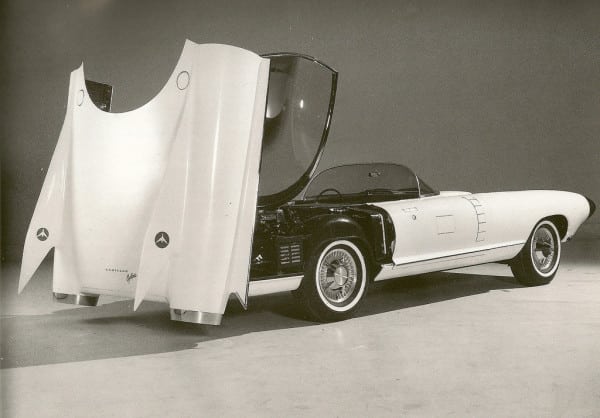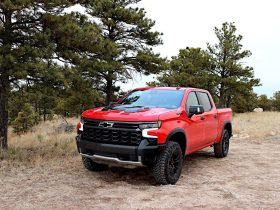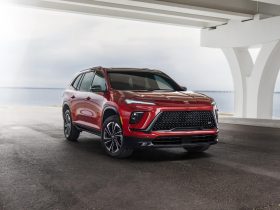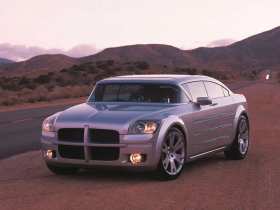The last of the legendary Harley Earl’s designs in which he directly participated, the Cadillac Cyclone was not only a beautiful design with a host of unprecedented firsts, but also a working prototype for something that is only now, more than half a century later, becoming commonplace.
The Cyclone, despite its name, was not a turbine-driven car, though accounts say that it originally was planned as such. The fledgling turbine program at General Motors, however, was not quite ready for show and would have to wait. The Cyclone would serve another purpose: it was Earl’s final shot at building a “dream car”. And the design genius went all out.
The Design of the Cadillac Cyclone
Earl’s career was guided by two major themes: low-riding, long, wide-wheelbases and aircraft-inspired looks with big tail fins. In that regard, his last creation was very much a culmination of his life’s work in design.
The 1959 Cadillac Cyclone was called the XP-74 internally and Earl enlisted veteran designer Carl Renner to help visualize the dream. Officially, Renner was working on the new Corvette, but unofficially, Earl’s personal dream car was priority. Earl was eager to finish it before his retirement at the end of the year in 1958. To facilitate this semi-clandestine priotization of work, a new door was added to the design studios to allow Renner to easily walk from one project to the other.
The photo above shows what Harley Earl had envisioned. It was another long, low, streamlined and jet-like car, this time with a retractable glass canopy (a special airbag cushion was devised in the trunk for it to rest upon when retracted). The design began using the 1959 Cadillac Series 62 convertible as a base, but the Cyclone is a far smaller vehicle with a shorter wheelbase and overall body, yet the gist of the Series 62’s shape remained intact.
The rounded, aircraft-fuselage-styled fenders and sides were accentuated while the center portions of the car were slimmed to add to the look. Small cuts and details hinted at jet airplane style, including a series of rectangular niches down the front of the door to indicate turbine expansion joints and the tail lamp bezels were unabashedly fashioned after turbine exhausts. Because the canopy was one-piece and did not have windows to be rolled down, large square ports in the doors were added to allow for cabin airflow.
To enter the car, the doors electrically opened by sliding forward while the canopy slipped up and back to give a large opening for entry and egress. Everything slid and snapped back into place securely when closed.
The beautifully-styled little car was finished with Cadillac’s latest engine, a 325 bhp, 390 cubic inch V-8. This sent power through the well-vetted Hydra-Matic transmission with a two-speed differential giving six total gears. A new, low-profile four-barrel carburetor with no air cleaner was installed under the filtered air scoop on the hood. All of this exhausted through a radically-designed manifold and muffler design that allowed the pipes to exit ahead of the front tires rather than down the frame to the rear.
The Cadillac Cyclone was finished on time, but ultimately, Earl’s retirement car was the Oldsmobile F-88, which was an entirely functional car, rather than the Cyclone. Although the Cadillac Cyclone was a driving prototype, it was full of technology that was not tested nor did that technology likely work as envisioned, given the capabilities of the time.
Technology Juts Forward
The most prominent feature of the Cadillac Cyclone was its jutting front fenders with their aircraft-nose cones. These cones housed radar sending/receiving units that were part of a futuristic, semi-functioning crash avoidance system. It was a forerunner to today’s common radar/visual systems for active cruise control and low-speed crash avoidance.
Other technologies were under the hood and very much understated, despite their radical shift from the norm for the day. The engine in the Cyclone was the latest Cadillac had to offer, but elements around it were far more advanced than was the engine itself.
All of the engine-driven accessories were mounted in front of the engine rather than on top of it. The air-suspension compressor (which also inflated the airbag for the canopy), power steering pump, generator, water pump, and air conditioning compressor were driven by belts from the crankshaft. Although we think of this as normal today, at the time, it was anything but ordinary. Twin fans sat in front of those accessories and pushed air through a newly-designed aluminum cross-flow radiator – another innovation for the time.
Other innovations that were hit-and-miss included the pressure servo (pressurized by the air compressor) to augment the brakes and the variable-ratio Saginaw rotary-valve power steering that would soon become one of Cadillac’s crowning achievements.
At the time, thoughts of “automated highways” were all the rage and like many prototypes of the time, the Cadillac Cyclone was fitted with sensors that could detect and follow “steering strips” embedded in the roadway. In tests at GM, on a track specifically built to include those strips, the design worked perfectly, but of course would never really come to fruition. The radar system was meant to augment this to prevent crashes.
Where Is It Now?
The current Cadillac Cyclone looks somewhat different from the original. Earl’s design included the large tailfins at the rear, but after he left and the car was first shown (appearing at the new Daytona International Speedway in Florida), new design chief William Mitchell cut down the fins to be a closer match to the Series 62. Mitchell’s distaste for large fins would change GM’s design future forever, bringing on the end of the tailfin era.
Mitchell also moved the tail lamps to the end of the bumper, had the problematic air ride suspension system removed and replaced with coil springs, and a few other modifications made to the car. It was shown a few more times, then retired to storage at GM in favor of Mitchell’s more conservative design plans.
The car was showcased in the GM museum for some time and then feared lost as it disappeared for over a decade. During that time, it was apparently in closed storage and nearly forgotten, but revived again now that these 1950s designs are becoming popular showpieces again.
The Cadillac Cyclone remains in the General Motors Heritage Museum collection. Its original pearl white paint has been replaced with a (more fitting) silver and the silver sunscreen lining on the inside of the glass has peeled off and was never replaced.










